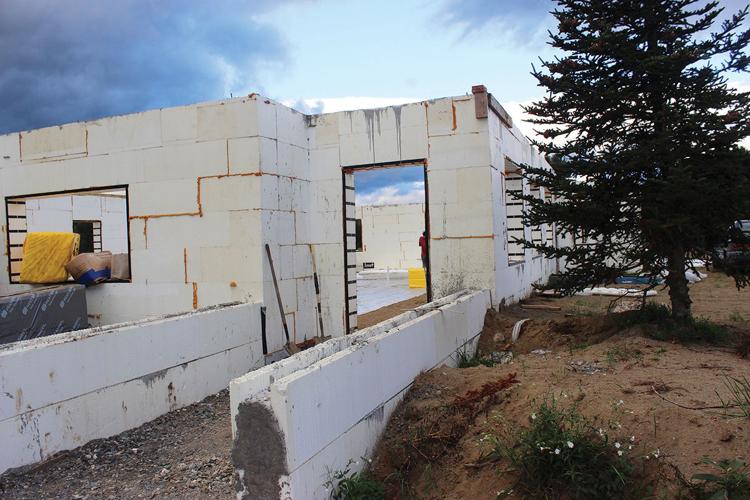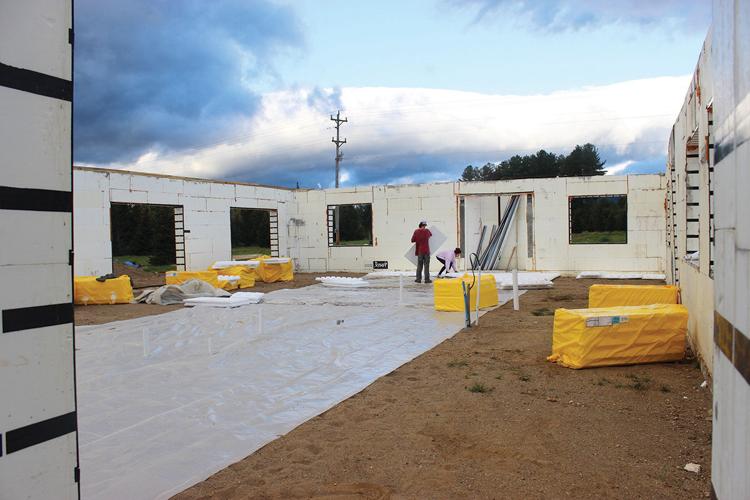Plastic foam is a good insulator, because it contains billions of trapped air bubbles. It’s used in hot-beverage cups, ice coolers, takeout containers — and for building houses in Lego-like fashion.
And when you have five kids, you have a labor force to get the job done.
Terence Jones, a single father raising five children, is building two new homes in Morristown — one for him and his kids, and another for his mother, Mary, who’d like to “live near me, not with me,” Jones said.
The main material for both homes is a product called Logix Blocks, which consist of foam panels, concrete, steel reinforcement, an air barrier and a vapor barrier with an exterior stucco finish.
To top it all off, Jones will install a low-pitch, seamed metal roof and low emissivity windows that will help control the radiant heat with a transparent, reflective metal oxide coating.
The result is a tight, Tudor-style, energy-efficient home that’s cool in the summer and warm in the winter.
Double entrances will further seal the homes from the outdoors, creating a pocket that will stop cold air from entering the living space in the winter.
The building is sealed so tightly that Jones will have to install a circulation system to move air into and out of his home.
“This is considered an advanced type of building system, even though I’ve been doing it for 35 years,” Jones said. “When I started out, the materials were harder to come by, but cheap to build with. Now they’re more abundant and more expensive.”
Jones says he has built similar homes in “every terrain and condition.”
While many Vermont residents like to build in the middle of the woods to insulate themselves from the sound of passing cars and manmade noise, Jones said the plastic foam will make his home basically soundproof, and the location near Paine’s Christmas Trees on Route 100 was the best place he could find.
It’s relatively flat and situated above any flood zones. The soil is hard-packed sand, which drains well.
Building a concrete and foam-based home costs about 5 percent more than constructing a traditional stick-built home, but once all is said and done, the costs saved on utilities outweigh the upfront price — especially since Jones plans to add solar panels onto the sunroom as well.
For Jones’ homes, his mother’s place will cost $100,000 for the shell, and the larger home will cost $160,000 for the shell.
The total cost of construction will depend on what materials Jones chooses for the interior, from flooring to kitchen fixtures, and right now he’s weighing options. Jones knows he doesn’t want to skimp when it comes to plumbing and heating, but could choose cheaper flooring.
While he’s never built a home like this in Vermont, Jones has built them in places like Missouri, Mexico and other parts of Latin America, and says they are made to withstand terrible weather.
“Missouri is tornado country, and we were the only family to build on a hill,” Jones said. “Everyone else built in the valleys for fear of tornado damage. We had some pretty close calls, but strapped down the roof, and didn’t have any damage.
“The winds would have to take these walls before it took my home,” Jones added, gesturing to the concrete and foam.
Given the Missouri experience, Jones has no worries about these homes surviving many Vermont winters, and he’s going big.
“There are only two reasons why people don’t build big,” Jones said. “They’re afraid of the cost to build or the taxes to follow. But I’m building with cash, which means no mortgage. … I bull’s-eye an area before I move, and look closely at the quality of life. The taxes are higher than when I lived in the South, but in Vermont you get what you pay for: a good education.”
Mary Jones’ single-story house will measure 1,500 square feet with skylights and a private outdoor patio.
The house for Jones and his kids house will have roughly 6,000 square feet of space on two stories. Jones wanted to give his kids as many opportunities as he could for activities and time together.
One of his daughters is really involved in ballet, so why not build a dance studio for her?
Jones likes art, and wants to get his children more involved, so an art studio is in the works.
And what home is complete without a full library and extensive commercial-style kitchen?
“For a smaller family, I understand smaller homes, but when increasing my footprint shouldn’t make my utilities cost any more than the traditional, small stick-built home, and I won’t have a mortgage, why not go big?” Jones said.
Construction began this spring, and the exterior should be completed before winter. The interior construction is expected to run into next summer. There were a few setbacks earlier in the year because of rain.
After the homes are completed, landscaping is the next project on Jones’ list. He is considering a small apple orchard near the road, and a pond on the backside of the property where his children can ice skate in the winter.
“If everyone built like this, we’d be more efficient and have less deforestation,” Jones said. “It’s good for the environment, which is something Vermonters have always been aware of.”























(0) comments
Welcome to the discussion.
Log In
Keep it clean. Please avoid obscene, vulgar, lewd, racist or sexual language.
PLEASE TURN OFF YOUR CAPS LOCK.
Don't threaten. Threats of harming another person will not be tolerated.
Be truthful. Don't knowingly lie about anyone or anything.
Be nice. No racism, sexism or any sort of -ism that is degrading to another person.
Be proactive. Use the "Report" link on each comment to let us know of abusive posts.
Share with us. We'd love to hear eyewitness accounts, the history behind an article.